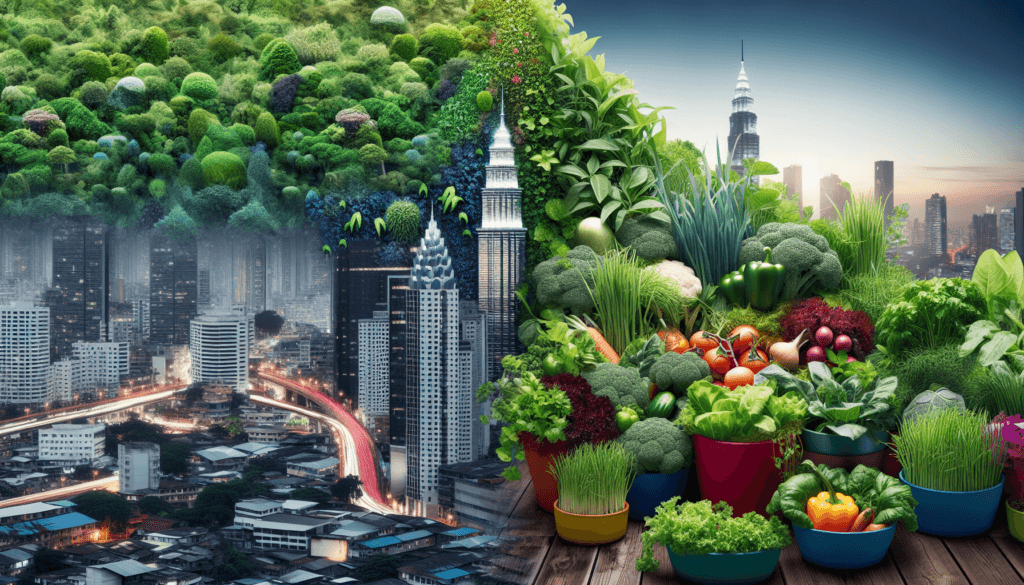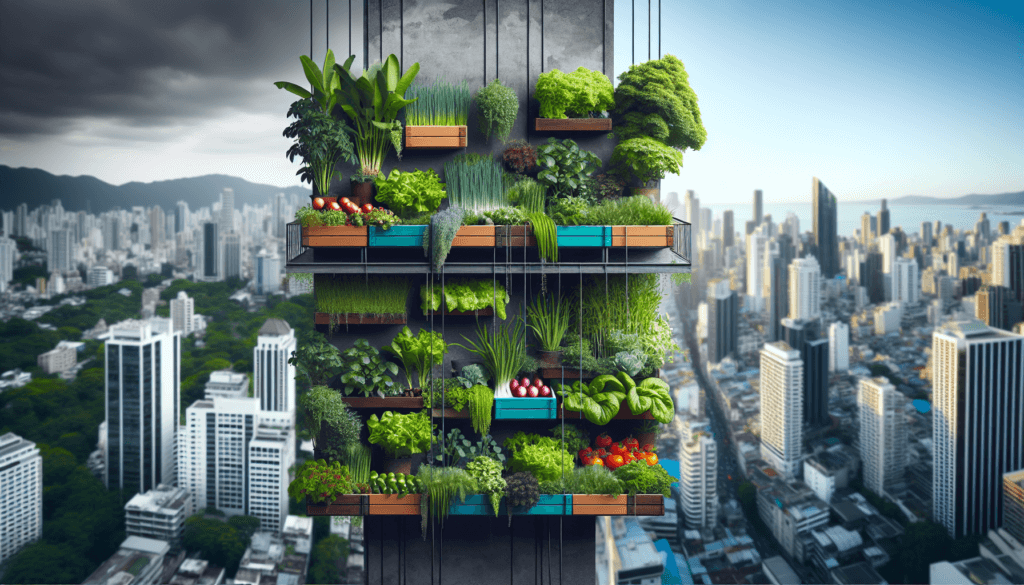Imagine transforming your concrete jungle into a lush oasis of greenery and life. Urban gardening offers a rejuvenating solution for those seeking a closer connection to nature in the midst of city living. By utilizing small spaces and creative techniques, you can cultivate vibrant gardens right on your doorstep. From vertical gardening on the sides of buildings to rooftop gardens overlooking the cityscape, the possibilities are endless. Get ready to embark on a journey of discovery as we explore the art of urban gardening, where every day is a breath of fresh air.

Benefits of Urban Gardening
Improves air quality
Urban gardening plays a crucial role in improving air quality in urban areas. Plants have the remarkable ability to absorb carbon dioxide and release oxygen through the process of photosynthesis. By cultivating plants in urban spaces, you can contribute to reducing air pollution and creating a healthier environment for yourself and the community. The presence of plants also helps to filter out harmful toxins and pollutants, making the air cleaner and fresher to breathe.
Boosts mental health
Engaging in urban gardening has significant mental health benefits. Spending time in nature and tending to plants can be relaxing and therapeutic, reducing stress and anxiety. Gardening provides an opportunity for you to connect with nature and take a break from the hustle and bustle of city life. It allows you to reconnect with the natural world and find solace in the beauty and tranquility of plants. The act of caring for plants can also give a sense of purpose and accomplishment, boosting self-esteem and mental well-being.
Increases access to fresh produce
One of the most rewarding aspects of urban gardening is the ability to grow your own fresh produce. By cultivating fruits, vegetables, herbs, and even edible flowers, you can have a readily available source of nutritious food right at your doorstep. Urban gardening promotes sustainable living and reduces the reliance on store-bought produce that may be treated with harmful chemicals or come from far away, contributing to carbon emissions. Having access to freshly harvested, organic produce not only benefits your health but also encourages others in the community to do the same.
Promotes community engagement
Urban gardening has the power to bring communities together and foster a sense of belonging. By participating in community garden projects or starting one yourself, you create opportunities for collaboration and collective action. It encourages neighbors to interact, share gardening knowledge, and exchange various tips and tricks. Community gardens often host events and workshops, allowing individuals to learn from experienced gardeners and develop new skills. The shared experience of working towards a common goal promotes social interaction, cooperation, and a stronger sense of community spirit.
Getting Started with Urban Gardening
Choosing the right location
When starting your urban garden, choosing the right location is crucial. Look for areas in your home or community that receive adequate sunlight and have good access to water. Consider factors such as the availability of space, soil quality, and proximity to other structures that may cast shadow on your plants. Urban gardens can be established in various places, including balconies, rooftops, patios, or even shared community spaces. Assessing the available space and its characteristics will help you determine the best location for your urban garden.
Determining sunlight exposure
Most plants require a sufficient amount of sunlight to grow and thrive. Assess the sunlight exposure in your chosen location to ensure that your plants have access to the necessary sunlight. Observe how many hours of direct sunlight the area receives and choose plant varieties that suit the light conditions. Leafy vegetables, for example, often require more sunlight, while some herbs can tolerate partial shade. Reflective surfaces around the area, such as walls or windows, can also increase the amount of sunlight available to your plants.
Selecting suitable containers or raised beds
In urban gardening, space is often limited, making containers or raised beds an ideal solution for growing plants. Select containers or raised beds that are appropriate for the type of plants you wish to grow and the available space. Consider factors such as drainage, size, and material. Containers should have adequate drainage holes to prevent waterlogging, while raised beds provide more planting space and allow better control over soil quality. Utilizing vertical gardening techniques, such as trellises or hanging baskets, can also maximize space utilization and create a visually appealing garden.

Selecting Plants for Urban Gardening
Choosing plants based on space limitations
In urban gardening, it is essential to choose plants that are suitable for the available space. While large vegetables like pumpkins or sprawling plants like watermelons may not be practical, compact varieties such as cherry tomatoes, herbs, or leafy greens can thrive in smaller areas. Additionally, consider using companion planting techniques where compatible plants are grown together to maximize space and minimize competition. By selecting plants that are well-suited for your space limitations, you can optimize your urban garden’s productivity and make the most out of limited space.
Opting for low-maintenance plants
For beginners or those with limited time and gardening experience, choosing low-maintenance plants can ensure a successful urban garden. Look for plant varieties that require minimal care, such as succulents, herbs like mint or rosemary, or flowering plants like marigolds. These plants are generally more resilient, have lower water and nutrient requirements, and can withstand environmental fluctuations. By opting for low-maintenance plants, you can enjoy the benefits of an urban garden while minimizing the time and effort required for maintenance.
Considering vertical gardening options
Vertical gardening is an excellent technique for maximizing space in urban gardening. By utilizing structures such as walls, fences, or trellises, you can grow plants vertically, taking advantage of unused vertical space. Vining plants like cucumbers, pole beans, or even flowers like morning glories can be trained to grow upwards. Additionally, vertical gardening can be achieved through the use of hanging baskets or wall-mounted planters. This technique not only saves space but also adds visual interest and creates a lush, green backdrop in urban environments.
Essential Tools and Supplies
Basic gardening tools
To get started with urban gardening, you will need a few basic gardening tools. These include a hand trowel for digging and transplanting, a garden fork or rake for loosening soil, pruning shears for trimming and shaping plants, and a watering can or hose for watering. Having these essential tools on hand will make your gardening tasks easier and more efficient. Invest in high-quality tools that are durable and comfortable to use, as they will be your reliable companions throughout your urban gardening journey.
Seeds or seedlings
To start growing plants in your urban garden, you will need seeds or seedlings. Seeds can be obtained from local nurseries, garden centers, or online retailers. Choose seeds that are suitable for your chosen plants and follow the instructions on the seed packets for proper planting and care. Alternatively, you can purchase seedlings or young plants from nurseries, which can save you time and allow for quicker establishment in your garden. Regardless of whether you choose seeds or seedlings, selecting quality plant material is essential for successful urban gardening.
Quality soil and compost
The quality of your soil is vital for the health and productivity of your plants. Urban environments often pose challenges in terms of soil quality, with compacted or depleted soils being common. Invest in quality potting soil or create your own by combining organic matter, such as compost, with sand or peat moss. Compost helps improve soil structure, provides essential nutrients to plants, and promotes healthy root development. By incorporating quality soil and compost into your urban garden, you will create a fertile environment for your plants to thrive.
Watering equipment
Proper watering is crucial for the success of your urban garden. Depending on the size and layout of your garden, you may need watering equipment such as a watering can, a hose, or a drip irrigation system. Choose watering equipment that suits your garden’s needs and allows for efficient and precise watering. Consider installing a rain barrel to collect rainwater, reducing water consumption and promoting sustainability. Having the right watering equipment will ease the task of watering your plants and help maintain adequate soil moisture levels.

Watering and Irrigation
Understanding watering needs
Watering your urban garden correctly is essential to ensure your plants receive the right amount of water. Different plant species have varying watering requirements, so it is crucial to understand the needs of your specific plants. Factors such as plant size, stage of growth, environmental conditions, and soil moisture levels influence watering needs. Overwatering can lead to root rot and other plant diseases, while underwatering can cause wilting or stunted growth. Regularly monitor the moisture levels of your soil and adjust your watering schedule accordingly to maintain optimum soil moisture.
Different irrigation methods
There are various irrigation methods available for urban gardening, each with its advantages and considerations. Traditional methods such as hand watering or using a watering can are suitable for smaller gardens but require more time and effort. Drip irrigation systems, on the other hand, provide efficient and controlled water delivery directly to the plant’s root zone. This method minimizes water loss due to evaporation and reduces weed growth. Sprinkler systems are also an option, particularly for larger urban gardens, but they may require more water and can contribute to water wastage if not optimized.
Designing a water-efficient system
Designing a water-efficient system is essential for sustainable urban gardening. Consider incorporating water-saving features such as rainwater harvesting, mulching, and water timers into your irrigation setup. Collecting rainwater in barrels or containers allows you to utilize a natural water source and reduce reliance on tap water. Mulching with organic materials like straw or wood chips helps retain soil moisture, suppress weed growth, and prevent evaporation. Water timers can be set to deliver water at specific times, ensuring consistent watering and preventing over or underwatering. By designing a water-efficient system, you can conserve water and promote sustainability in your urban garden.
Pest and Disease Management
Identifying common urban garden pests
Urban gardens are not immune to pests, but by identifying and addressing them promptly, you can minimize their impact on your plants. Common pests in urban environments include aphids, slugs, snails, caterpillars, and spider mites. Regularly inspect your plants for signs of pest infestation, such as holes in leaves, chewed stems, or discolored foliage. Early detection allows you to take appropriate measures to prevent pest populations from getting out of control and damaging your urban garden.
Implementing natural pest control methods
In urban gardening, it is advisable to employ natural pest control methods that are safe for both the environment and your plants. Avoid using harmful chemical pesticides that can have adverse effects on beneficial insects, pollinators, and even human health. Instead, you can use organic pest control measures such as handpicking pests off plants, using insecticidal soaps or oils, introducing beneficial insects like ladybugs or lacewings, or planting companion plants that repel pests naturally. These natural methods provide effective pest control while maintaining the overall health and balance of your urban garden.
Preventing plant diseases
Preventing plant diseases is essential for maintaining healthy plants in your urban garden. Ensure good airflow and spacing between plants to reduce humidity and prevent fungal diseases. Proper watering practices can also help prevent diseases caused by over or underwatering. Avoid working with wet plants or soil to minimize the spread of fungal spores. Remove and discard infected plant material promptly to prevent the spread of diseases. Additionally, practicing crop rotation and avoiding overcrowding can help prevent the buildup of diseases in the soil. By adopting preventive measures, you can minimize the occurrence and impact of diseases in your urban garden.

Harvesting and Maintenance
Harvesting techniques
Harvesting the fruits of your labor is one of the most rewarding aspects of urban gardening. Each plant has its unique harvesting techniques, so it is important to familiarize yourself with the specific requirements of the plants you are growing. For example, leafy greens can be harvested by picking individual leaves as needed, while fruits like tomatoes or peppers should be harvested when fully ripe. Herbs can be harvested by cutting off sprigs as required. When harvesting, use clean and sharp tools to avoid damaging the plants and ensure proper post-harvest handling to maintain the freshness and quality of your produce.
Proper pruning and trimming
Regular pruning and trimming are integral parts of maintaining healthy and productive plants in your urban garden. Pruning involves removing dead or diseased branches, promoting better air circulation, and shaping the plant to maintain its size and form. Trimming, on the other hand, involves removing excess growth, such as wild branches or non-essential leaves. Both practices help stimulate new growth, increase plant vigor, and prevent overcrowding. It is important to use sharp and clean pruning tools to ensure precise and clean cuts, minimizing the risk of introducing diseases to your plants.
Weeding and soil maintenance
Weeding and soil maintenance are essential tasks to keep your urban garden thriving. Weeds compete with your plants for nutrients, water, and sunlight, so regular weeding is necessary to prevent them from overtaking your garden. Use hand tools or a hand weeder to remove weeds, ensuring that you remove both the foliage and the roots. Additionally, regularly inspect your soil for compaction and loosen it with a garden fork or rake if needed. Maintain a layer of organic mulch on the soil surface to suppress weed growth, regulate soil temperature, and retain soil moisture. By staying on top of weeding and soil maintenance, you create a favorable environment for your plants to grow and produce abundantly.
Creative Urban Gardening Ideas
Vertical gardens on walls
One creative idea for urban gardening is to utilize vertical spaces such as walls to create a stunning green wall or vertical garden. By installing wall-mounted planters, pockets, or trellises, you can grow a variety of plants vertically, adding a vibrant and visually appealing element to your urban environment. Choose trailing plants, climbers, or compact herb varieties that are suitable for vertical growth. Vertical gardens not only save space but also create a beautiful focal point, improving the aesthetics of your urban garden and making a statement in your community.
Window or balcony gardens
Windowsills and balconies are perfect areas for urban gardening, allowing you to enjoy the beauty of plants even in limited spaces. Hang planters or window boxes outside your windows or place containers on your balcony railing, filling them with colorful flowering plants, aromatic herbs, or cascading vines. Choose plants that thrive in the available sunlight and create a mini garden that brings joy and freshness to your surroundings. Window or balcony gardens not only enhance the visual appeal of your urban space but also connect you with nature on a daily basis.
Community garden projects
Engaging in community garden projects is an excellent way to contribute to the development of a greener and more sustainable urban environment. Collaborate with like-minded individuals in your community to establish a shared garden space where everyone can grow plants and share the harvest. Community gardens foster camaraderie, encourage knowledge exchange, and provide an opportunity for individuals to make a collective impact. Participate in garden workdays, workshops, or events organized by community garden projects to further enhance your urban gardening skills and connect with others who share your passion.

Overcoming Challenges in Urban Gardening
Limited space and sunlight
One of the primary challenges in urban gardening is limited space and sunlight availability. However, with proper planning and creative solutions, these challenges can be overcome. Utilize vertical gardening techniques to maximize space usage and grow plants vertically. Choose varieties that are suitable for small spaces and can tolerate partial shade if sunlight is limited. Additionally, consider utilizing reflective surfaces, such as mirrors or white walls, to increase the amount of sunlight reaching your plants. By adapting to limited space and sunlight, you can still create a thriving urban garden.
Dealing with urban pollution
Urban environments often come with pollution challenges that can impact the health and growth of your plants. Air pollution, heavy metals, dust, and chemical contaminants can affect plant growth and overall plant health. To combat pollution, consider installing air purifying plants, such as spider plants or peace lilies, in your urban garden. These plants have the ability to absorb pollutants and improve air quality. Regularly clean your plants’ foliage to remove dust and pollutants accumulation. Creating a barrier, such as hedges or tall plants, can also shield your garden from pollutants. By taking measures to mitigate urban pollution, you can create a healthier growing environment for your plants.
Addressing potential theft or vandalism
Urban gardening sometimes faces the challenge of potential theft or vandalism, especially in public or shared spaces. To protect your urban garden, consider implementing deterrents such as installing garden fences, using thorny plants as natural barriers, or installing security cameras if permitted. Engaging the community and raising awareness about the importance of urban gardening can also help discourage theft or vandalism. Promote community involvement in the garden, organize events, or establish a neighborhood watch system. By fostering a sense of ownership and collective responsibility, you can create an environment where your urban garden is respected and protected.
Urban Gardening Tips for Beginners
Start small and gradually expand
If you are new to urban gardening, it is advisable to start small and gradually expand your garden as you gain more experience and confidence. Begin with a few pots or containers, focusing on easy-to-grow plants like herbs or leafy greens. As you become more comfortable with the basics of gardening, you can experiment with different plant varieties, techniques, and expand your garden space. Starting small allows you to learn and adapt to the challenges of urban gardening while preventing overwhelm and maximizing your chances of success.
Educate yourself about plant care
A key factor in successful urban gardening is having a good understanding of plant care requirements. Take the time to educate yourself about the specific needs of the plants you wish to grow. Familiarize yourself with topics such as watering, fertilization, pruning, and pest management. Join gardening forums or online communities to connect with experienced gardeners and learn from their knowledge and expertise. Books, magazines, or online resources can also be valuable sources of information. By continuously learning and staying informed, you can develop the necessary skills to nurture and care for your urban garden.
Join local gardening communities
Engaging with local gardening communities is an excellent way to learn, seek guidance, and connect with fellow urban gardeners. Search for local gardening clubs, community gardens, or social media groups dedicated to gardening in your area. By joining these communities, you can benefit from shared knowledge, exchange tips and ideas, and even participate in group activities such as seed swaps or garden tours. Gardening communities offer a supportive and enriching environment that can inspire and motivate you on your urban gardening journey.
In conclusion, urban gardening is a rewarding and fulfilling activity that offers numerous benefits. By improving air quality, boosting mental health, increasing access to fresh produce, and promoting community engagement, urban gardening has the potential to transform urban environments into greener, healthier, and more vibrant spaces. From choosing the right location and selecting suitable plants to investing in essential tools and supplies, understanding proper watering and irrigation techniques, managing pests and diseases, and exploring creative gardening ideas, there is much to explore and learn in the realm of urban gardening. With determination, patience, and a commitment to sustainability, you can cultivate a thriving urban garden that brings beauty, nutrition, and a sense of fulfillment to your life and community. So embark on your urban gardening adventure, and let the joy of gardening flourish in the heart of the city.

